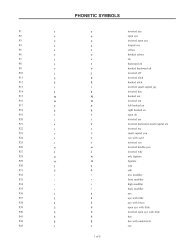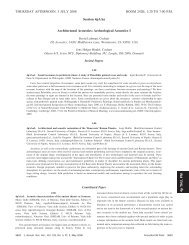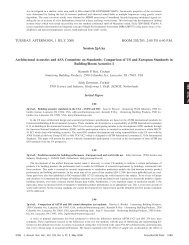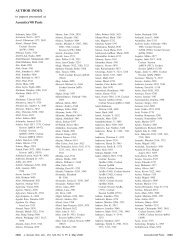Tuesday afternoon, 11 November - The Acoustical Society of America
Tuesday afternoon, 11 November - The Acoustical Society of America
Tuesday afternoon, 11 November - The Acoustical Society of America
Create successful ePaper yourself
Turn your PDF publications into a flip-book with our unique Google optimized e-Paper software.
TUESDAY AFTERNOON, <strong>11</strong> NOVEMBER 2008 LEGENDS 10, 1:00 TO 3:00 P.M.<br />
Session 2pPA<br />
Physical Acoustics: Topics in Nonlinear Acoustics<br />
Zhiqu Lu, Cochair<br />
Univ. <strong>of</strong> Mississippi, Natl. Ctr. for Physical Acoustics, 1 Coliseum Dr., University, MS 38677<br />
James M. Sabatier, Cochair<br />
Univ. <strong>of</strong> Mississippi, Natl. Ctr. for Physical Acoustics, 1 Coliseum Dr., University, MS 38677<br />
1:00<br />
2pPA1. Higher-order statistical analysis <strong>of</strong> nonlinearly propagated<br />
broadband noise. Micah R. Shepherd and Kent L. Gee Dept <strong>of</strong> Phys. and<br />
Astronomy, Brigham Young Univ., N283 ESC, Provo, UT 84602<br />
Nonlinearity indicators have recently been used to identify and characterize<br />
nonlinear effects present in high-amplitude noise propagation. Although<br />
frequency-domain approaches have many benefits, a time-domain<br />
approach may be a more natural fit for the time-domain phenomenon <strong>of</strong><br />
wave form steepening and shock formation. Standard skewness and kurtosis<br />
metrics are computed for propagated Gaussian noise at both low and high<br />
amplitudes. <strong>The</strong> same higher-order statistics are also computed for the first<br />
time derivative <strong>of</strong> the propagated noise in order to accentuate non-Gaussian<br />
variation in the wave form. <strong>The</strong> results appear to reveal an asymptotic behavior<br />
<strong>of</strong> the statistical quantities as the time wave form becomes more<br />
shock dominated.<br />
1:15<br />
2pPA2. Ultrasonic wave generation by means <strong>of</strong> highly nonlinear waves’<br />
sensor technology. Piervincenzo Rizzo Dept. <strong>of</strong> Civil and Environ. Eng.,<br />
Univ. <strong>of</strong> Pittsburgh, 942 Benedum Hall, 3700 O’Hara St., Pittsburgh, PA<br />
15261, pir3@pitt.edu, Devvrath Khatri, and Chiara Daraio California Inst.<br />
<strong>of</strong> Technol., Pasadena, CA 9<strong>11</strong>25<br />
This paper describes an innovative approach to generate and sense pulse<br />
waves in structural materials. <strong>The</strong> approach is based on the generation <strong>of</strong><br />
highly nonlinear solitary waves HNSWs. HNSWs are stress waves that can<br />
form and travel in highly nonlinear systems i.e., granular, layered, fibrous,<br />
or porous materials with a finite spatial dimension independent <strong>of</strong> the wave<br />
amplitude. Compared to conventional linear waves, the generation <strong>of</strong><br />
HNSWs does not rely on the use <strong>of</strong> electronic equipment such as an arbitrary<br />
function generator and on the response <strong>of</strong> piezoelectric crystals or<br />
other transduction mechanism. HNSWs possess unique tunable properties<br />
that provide a complete control over tailoring: 1 the choice <strong>of</strong> the waves’<br />
width spatial size for defects’ investigation, 2 the composition <strong>of</strong> the excited<br />
train <strong>of</strong> waves i.e., number and separation <strong>of</strong> the waves used for<br />
testing, and 3 their amplitude and velocity. HNSWs are excited onto concrete<br />
samples and steel rebar. <strong>The</strong> characteristics <strong>of</strong> the pulses traveling<br />
along simple waveguides such as metallic plates and rods are experimentally<br />
studied.<br />
1:30<br />
2pPA3. Nonlinear acoustic phenomena in viscous thermally relaxing<br />
fluids: Shock bifurcation and the emergence <strong>of</strong> diffusive solitons. Pedro<br />
Jordan U.S. Naval Res. Lab., Stennis Space Ctr., Code 7181, MS 39529<br />
In this talk, we will consider the propagation <strong>of</strong> finite-amplitude acoustic<br />
waves in fluids that exhibit both viscosity and thermal relaxation. Under the<br />
assumption that the thermal flux vector is given by the Maxwell–Cattaneo<br />
law, which is a well known generalization <strong>of</strong> Fourier’s law that includes the<br />
effects <strong>of</strong> thermal inertia, we derive the weakly nonlinear equation <strong>of</strong> motion<br />
in terms <strong>of</strong> the acoustic potential. We then use singular surface theory to<br />
determine how an input signal in the form <strong>of</strong> a shock wave evolves over<br />
Contributed Papers<br />
time and for different values <strong>of</strong> the Mach number. <strong>The</strong>n, numerical methods<br />
are used to illustrate our analytical findings. In particular, it is shown that the<br />
shock amplitude exhibits a transcritical bifurcation; that a stable nonzero<br />
equilibrium solution is possible, and that a Taylor shock i.e., a diffusive<br />
soliton, in the form <strong>of</strong> a “tanh” pr<strong>of</strong>ile, can emerge from behind the input<br />
shock wave. Finally, an application related to the kinematic-wave theory <strong>of</strong><br />
traffic flow is noted. Work supported by ONR/NRL funding PE<br />
06<strong>11</strong>53N.<br />
1:45<br />
2pPA4. Intensity and temperature variance in sonoluminescence. Lyric<br />
Gillett 1821 Harvard St., Houston, TX 77008, mjcgillett@comcast.net<br />
Sonoluminescence is the process in which light is produced through ultrasonic<br />
pressure waves causing the expansion and subsequent collapse <strong>of</strong> a<br />
gas/vapor bubble, held in an ultrasonic standing wave pattern, in water. This<br />
study measured sonoluminescent bubble light intensity output utilizing a<br />
photomultiplier tube and a lock-in amplifier to determine the relationship <strong>of</strong><br />
the sonoluminescent intensity to variance in water temperature. <strong>The</strong> results<br />
could be indicative <strong>of</strong> the optimal temperatures at which to conduct sonoluminescence<br />
research, and assist in facilitating and advancing sonoluminescence<br />
research ventures relating to further study <strong>of</strong> energy production and<br />
nuclear reactions. Though not part <strong>of</strong> the experimental design, the initial experimentation<br />
suggested a positive correlation between the drive level <strong>of</strong> the<br />
transducer and the light intensity from the sonoluminescent bubble. Further<br />
experimentation was conducted in which the transducer drive signal and frequency<br />
were continuously optimized as the water temperature rose. After<br />
data were graphed and analyzed, it was determined that there was a decrease<br />
in sonoluminescent intensity as the water temperature increased. It is believed<br />
that this experimentation resulted in a greater plasma density inside<br />
the sonoluminescent bubble. To that end, future experimentation, as well as<br />
potential military and medical applications, interests this researcher.<br />
2:00<br />
2pPA5. Nonlinear resonance frequency shifts in acoustical resonators<br />
with varying cross sections. Yurii A. Ilinskii, Mark F. Hamilton, and<br />
Evgenia A. Zabolotskaya Appl. Res. Labs., <strong>The</strong> Univ. <strong>of</strong> Texas, P.O. Box<br />
8029, Austin, TX 78713-8029<br />
<strong>The</strong> frequency response and nonlinear resonance frequency shift for an<br />
acoustical resonator with losses and having a varying cross section were investigated<br />
previously using Lagrangian mechanics for resonator shapes that<br />
are close to cylindrical J. Acoust. Soc. Am. <strong>11</strong>0, 109 2001. <strong>The</strong> same<br />
approach is extended to include resonators having any shape for which a<br />
one-dimensional Webster-type equation is a valid model in the linear<br />
approximation. Admissible shapes include cones and bulbs proposed for<br />
acoustical compressors. <strong>The</strong> approach is appropriate for approximate but<br />
rapid parameter estimations for resonators with complicated shapes, requiring<br />
100 times less computer time than for direct numerical solution <strong>of</strong> the<br />
one-dimensional model equation ordinarily used for these resonators Ilinskii<br />
et al., J. Acoust. Soc. Am. 104, 2664 1998. Results for cone and bulb<br />
shaped resonators with losses are compared with results from the previous<br />
one-dimensional theory and with experimental data. It is shown that the di-<br />
2491 J. Acoust. Soc. Am., Vol. 124, No. 4, Pt. 2, October 2008 156th Meeting: <strong>Acoustical</strong> <strong>Society</strong> <strong>of</strong> <strong>America</strong><br />
2491<br />
2p TUE. PM







